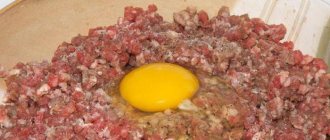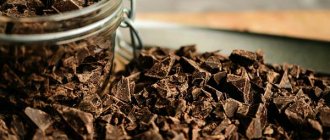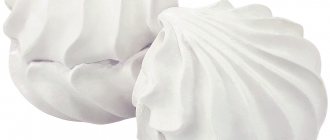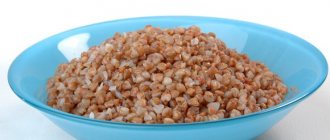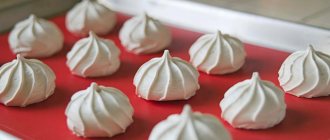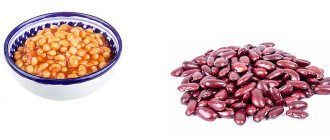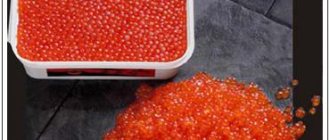A cake is a small piece confectionery product of various shapes, made from dough and various types of fillings. Often the cakes have an original artistic design. “Pirozhnoye” is the Russian name for a class of confectionery products, according to one of the culinary critics, who are not united by any common principle. However, there is still a common feature of all cakes, regardless of the composition, method of preparation, or filling. Cakes, as a rule, are always small in size, which is its main insidiousness. Since the cakes are small in size, the calorie content of the cakes is quite high.
Calorie content of Potato cake
These cakes are made from sponge or shortbread cookies, and the calorie content of a Potato cake made from a sponge cake is lower than a cake made from cookies. Cookies or biscuit are crushed into crumbs, mixed with condensed milk, butter and cocoa powder, you can also add nuts to it. This cake is prepared without baking - you simply form “lumps” from the biscuit-chocolate mass, which you then decorate with nuts or cream.
For their rich taste and ease of preparation, these cakes are loved by both adults and children. The calorie content of the Potato cake is 380-400 kcal per 100 g
. The weight of one cake that fits in the palm of your hand is approximately 70-80 g.
Calorie content of the “Basket” cake
“Basket” is a cake familiar to everyone since childhood. This is a tartlet made of shortcrust pastry, in which there is berry jam at the bottom, and on it there are figures made of butter and protein cream, decorated with candied berries, candied fruits, cream flowers (however, there may not be any jam).
The calorie content of the “Basket” cake depends on the cream. For example, 100 g of a cake with protein cream contains about 370-380 kcal, and a cake with butter cream will already have up to 420 kcal per 100 g. The weight of one cake is approximately 60-90 g (with butter cream it is heavier).
Calorie content of custard cake
Custard cakes are also loved by many - they are one of the most popular among cakes. Unfortunately, they are also very high in calories. The dough also contains a lot of calories, since it contains a large amount of fat, and cream. Different types of cream are used in custard cakes - butter, butter, protein, curd or custard. Depending on this, the calorie content of the custard cake may vary.
Buttercream has the highest calorie content - 500-560 kcal per 100 g. It is harmful for people with diseases of the liver, pancreas, biliary tract, as well as a tendency to be overweight. Less harmful and high in calories is protein cream, whose calorie content is about 250-350 kcal per 100 g, depending on its sweetness, that is, on how much sugar the confectioner puts in it. The calorie content of custard cake with protein cream is 280-300 kcal.
The calorie content of custard is even lower - 220 kcal per 100 g, and if you prepare it without oil, then the calorie content of the custard will become about 150-170 kcal per 100 g. However, cake manufacturers, in order to reduce the cost of production, not only do not refuse butter in the cream , but they also replace butter with cheap fats - margarine or palm oil, which makes the calorie content of the product higher and also increases its harm to health. The calorie content of custard cake with curd cream is about 280 kcal per 100 g
, and the cream itself contains 160-170 kcal per 100 g.
How many calories are in desserts - Top popular high-calorie desserts

You have to fight the temptation to eat something tasty every day. Airy tiramisu, delicate cheesecakes and delicious chocolate brownies. Even if you follow the “fats and carbohydrates before lunch” rule, and drink half a liter of water twenty minutes before meals, a portion of the treat will inexorably settle on your thighs.
So, how many calories are there in our beloved desserts? What can you pamper yourself with and what calorie content can make up half the daily diet of an adult.
Calorie content of Tiramisu
Tiramisu contains more than 300 Kcal per 100 g according to the classic recipe. If the dessert is prepared using alcohol, the calorie content may exceed 500 Kcal.
The first mention of the famous dessert appeared in the late 70s; the author of the masterpiece is considered to be the Italian confectioner Roberto Linguanotto. The history of tiramisu is still shrouded in rumors and legends. One of them says that for the first time this dessert called “Zuppa del duca” was prepared especially for the Grand Duke of Tuscany, Cosimo III de’ Medici. Many Italian restaurants and confectioners, including our contemporaries, also lay claim to the authorship of this favorite delicacy.
The dessert received its Italian name “tira mi su”, which means “raise me”, due to the restorative and nutritional properties of the ingredients. Indeed, it is rich in potassium and magnesium and is therefore beneficial for the circulatory system. Despite its high calorie content, tiramisu contains a relatively small proportion of fat - 15-20%, and is easily digestible.
Cheesecake calories
There is an opinion that cheesecake is the most high-calorie dessert known. Its energy value can be 200 or 500 Kcal per 100 g, depending on the recipe. Classic New York has about 300 kcal.
This dish is high in calories and contains a lot of animal proteins. If you are actively involved in sports, eating cheesecakes can lead to muscle gain. Not surprisingly, cheesecakes first appeared in Ancient Greece. “Placenta,” as this dessert was called, was made from cottage cheese and served to athletes at the Olympic Games.
Modern cheesecake came to us from the USA, where at the beginning of the twentieth century the famous restaurateur Arnold Reuben first prepared a dessert from cream cheese.
Calorie content of Eclairs
Source: https://ladydiary.ru/zdorove-ledi/diety-i-zdorovoe-pitanie/skolko-kalorii-v-desertah-top-populjarnyh-kaloriinyh-desertov.html
Calorie content of sponge cakes and meringues
Meringue cakes are made from egg whites and a lot of sugar, whipped into cream and baked in the oven. The calorie content of meringue cakes is about 375 kcal per 100 g, while the weight of one cake with a diameter of 3-5 cm is about 10 g.
Sponge cakes are made from sponge dough, greased and soaked in various creams and syrups, decorated with icing, nuts, chocolate, marmalade, candied fruits and berries, etc. The calorie content of sponge cakes ranges from 250 to 450 kcal
, and depending on the filling it can be higher.
Calorie content of Macarons
Macarons are French pastries that consist of two round cookies joined together with cream or jam. Their peculiarities, firstly, are that they are prepared from almond flour, and secondly, they must be colored, that is, food coloring must be used in their preparation. The cake layers of these cakes are so light that they literally melt in your mouth. The calorie content of macaroons is on average 400-420 kcal per 100 g - the higher the calorie content of the filling, the higher the calorie content of the cakes.
The lowest calorie cakes
If you are on a diet, sometimes it can be quite difficult to resist eating something tasty, and if your carbohydrate intake is greatly reduced during the diet, you begin to crave sweets especially strongly. You shouldn’t torture yourself and deny yourself pleasure, but remember the calorie content of the cakes you are going to eat.
Choose the least calorie sweets or prepare them yourself.
For example, “Potato” cakes made from regular crackers without cream, profiteroles with curd or yogurt cream, biscuits with curd or sour cream, and cakes with pudding, jelly or fruit fillings are low in calories. If you liked this article, please vote for it:
(13 Votes)
A beautiful and appetizing cake, decorated with icing and creamy curls, is a real explosion of taste and positive emotions. But many of us hesitate to treat ourselves to such a delicacy, fearing for our figure. Cakes, despite their external fragility and tenderness, are very high in calories and often you have to pay extra pounds for a moment of pleasure.
To make cakes, a lot of butter is used, both butter and vegetable oil, cocoa butter and coconut oil. They contain eggs, a lot of sugar and dairy products, and everyone knows that there are a lot of calories in cream, condensed milk and buttercream. The high calorie content of cakes has made them a forbidden fruit for many.
In addition, many different additives are added to the cakes, such as nuts, poppy seeds, dried fruits, halva and marmalade, and many other products, such as dyes and flavors. Cakes are soaked in a variety of sweet syrups, creams with cognac and cocoa, and decorated with cream, fruits or candied fruits. Cakes can be sponge cake, puff pastry, custard, meringue, but in any case the caloric content of cakes remains high.
Cakes
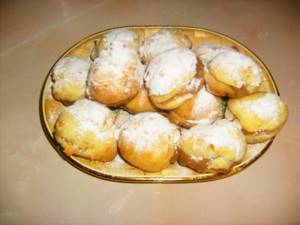
One of the favorite delicacies of all those with a sweet tooth is cakes. We owe the appearance of such a varied delicacy to French confectioners. It is thanks to their culinary imagination that today we treat ourselves to airy meringues, eclairs and profiteroles, all kinds of soufflés and other delicacies. The cake as a separate confectionery product appeared after cooks began to portion whole cakes into small pieces.
Among confectionery products, cakes occupy a special place, since the dish uses a set of ingredients that you rarely find in another confectionery in the same composition. An exception may be cakes and some cookies. Cakes with different compositions have different effects on our body. How does this happen?
"Disadvantages" of cakes
The most common opinion about the dangers of confectionery products is related to their ability to affect the slimness of the figure. And all because any cake contains an “explosive mixture” of cream and sugar.
Everything is very simple, such a delicious combination - sugar and cream filling (sour cream, cream) - is the highest calorie synthesis. Regular sugar is a simple carbohydrate that is considered a valuable nutrient that replenishes the lack of energy necessary to maintain life. Excess sugar in the body is transformed into fat tissue.
As for the fats in the cake, they have a much faster effect on the formation of fat deposits in the body. Fatty foods are best consumed in the cold season, as everyone knows that in conditions of low temperatures this substance becomes an indispensable source of additional heat.
The cream contained in the confectionery product is also an additional source of cholesterol. This substance is necessary for the body to maintain synthetic and regulatory functions, but its excess can lead to blockage of the arteries and the development of atherosclerosis. It is worth noting that an excess of this substance is much more common in the body than its deficiency.
An ingredient in the cake, such as bird's eggs, also increases the level of cholesterol in the product. Eggs contain the most of this substance. But the cream filling is not the only harmful part of the confectionery.
Dough
Choux or puff pastry will help reduce the caloric content of the filling. But it is the dough that can become an additional “fly in the ointment” of the whole dish. For example, dough made from wheat flour, after several stages of processing (kneading and heat treatment), becomes a product containing easily digestible carbohydrates. As a result of exposure to flour, the product loses biologically active components and vitamins that were previously present in the ingredient.
After absorbing carbohydrates alone, the body begins to actively convert them into energy. The lack of energy expenditure is fraught with the fact that the substance transforms into a different quality - fat cells are formed. Therefore, flour dough adds “fatty” qualities to high-calorie cream, which doubly affects slender and beautiful body shapes.
Confectionery admixtures
Modern confectioners rarely prepare cakes without adding category E impurities to the product. These can be food coloring and emulsifiers, flavorings, stabilizers and acidifiers. Note that these additives are present not only in industrial production, but also in home baking.
True, the housewife most often uses natural, well-known ingredients, but in an industrial confectionery shop for making cakes, more effective substances can be used in the product composition.
A fairly common phenomenon nowadays is the “forgetfulness” of players in the food products market to warn consumers about such specific additives.
"Pros" of the cake
What are we all about the harmful effects? If the picture were really painted only in black colors, it is unlikely that we would have such an abundance of confectionery products today. First of all, cakes are antidepressants; they create a mood. It’s hard to imagine, but it is the same sugar that affects these processes. The substance leads to an abundant release of serotonin, the so-called “hormone of joy,” which awakens fun in us.
THIS IS INTERESTING: How many calories are in dates?
Note that calories are not always extra. For example, replenishing energy is very useful for those who are in a decadent mood or engaged in intense mental or physical labor.
In addition, the egg white and cream filling contain beneficial amino acids. And cakes with fruits, berries or nuts increase the supply of vitamins and nutrients to the body along with the sweets eaten.
Since cakes belong to the category of perishable products, the finished product should be stored for no more than one and a half days.
No matter how you feel about cakes, they can be a little culinary indulgence at the end of a busy day. People often treat themselves to sweets as a way to further praise or reward them for something, or simply to lift their spirits. During the day, it is better not to indulge in sweets, but to enjoy a delicious eclair with a glass of kefir or yogurt with fruit, a handful of berries or a few nuts.
When choosing cakes, pay attention to their composition. It is preferable to buy products made from puff pastry; the cream should be a natural shade without dyes or synthetic additives. An excellent choice would be cakes with the addition of cocoa, fruits, nuts or berries. Sweets purchased or prepared wisely will help minimize the negative impact of the product on the body, while maximizing their beneficial properties.
Source: https://www.poedim.ru/content/751-pirozhnye
Calorie content of cakes, their composition and properties
Today there is a huge variety of cakes, and the constant development of technology suggests that their number will continue to increase. The calorie content of cakes depends on the type of dough, as well as filling and cream, so to find out how many calories are in a cake, you need to study its composition. The most popular trust for cakes is biscuit with a calorie content of up to 320 calories per 100 g, shortbread with a calorie content of up to 410 calories per 100 g, puff pastry - up to 360 kcal and custard - up to 270 kcal.
It is also necessary to take into account the calorie content of the cream. One of the most popular creams is custard, the calorie content of which reaches 220 kcal per 100 grams of product. Curd fillings for cakes can contain up to 250 kcal per 100 grams, the calorie content of condensed milk is 320 kcal, jelly is 120 kcal, chocolate is from 400 to 580 kcal.
Many of us can't imagine having tea or afternoon coffee without a cake, but a small cake can pack a lot of calories. The average calorie content of a cake is approximately 300 kcal, and its weight is from 70 to 120 grams.
The high calorie content of this product could be neglected if it contained many vitamins or other substances necessary for human life. But cakes usually contain “empty” calories, pure energy that must be immediately wasted, otherwise it will be stored as fat reserves. Therefore, you should eat cakes only before serious physical activity, and in no case before sleep or rest.
Is it possible to choose a low-calorie cake?
If you really want something tasty, but you’ve already heard about the calorie content of cakes, many people have the idea to choose the least calorie-rich one and enjoy it. Probably the most popular in our country are custard cakes and Potato cakes. By the way, they are often classified as the least caloric.
The calorie content of a potato cake is determined by its composition. It can reach 360 kcal, but such cakes are rare. Usually in pastry shops we buy Potato cake, prepared according to the classic recipe and its calorie content is only 280 kcal. This cake contains cookies, condensed milk, cocoa, butter, fruits and nuts.
Of course, the calorie content of potato cake does not allow it to be called a dietary food, but there are ways to reduce it. To get a lower calorie content, it is prepared with bread crumbs instead of cookies, and you can also reduce the amount of butter. But, despite such steps, the calorie content of potato cake remains high and you should not consume it more than once a week.
The calorie content of custard cake is even higher; it can be up to 460 kcal, depending on the ingredients. A regular custard cake is a tube filled with cream and covered with chocolate or other glaze. Depending on the calorie content of the cream, the calorie content of the custard cake may vary. The cake can be filled with curd cream with a calorie content of up to 250 calories, buttercream with a calorie content of up to 220 calories, or protein cream with a calorie content of up to 225 calories.
You can reduce the calorie content of custard cake only by replacing the cream with a less calorie one. If you use low-fat cottage cheese and a minimum of sugar to prepare the cream, you will get a cake with less calories, but still not dietary.
In general, there are no diet cakes, but you can try replacing them with jelly or marmalade; marshmallows also have fewer calories. You can try making cakes from marshmallows, dried fruits, and nuts. They, of course, cannot compare with sponge cakes and delicate butter and butter creams, but they will help you not gain excess weight.
How did the sweetness appear?
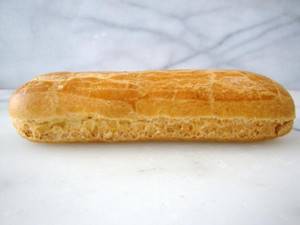
Custard cake or eclair appeared thanks to the famous French pastry chef Marie-Antoine Carema. He always dreamed of creating the best dessert in the world, which would become incredibly popular. He managed to do this in the 18th century. He developed his creation for a long time, and after years of painstaking work, the confectioner received excellent results. He created a quiche with 433 calories.
It was Carême’s work that gave impetus to the subsequent development of confectionery art not only in France, but throughout the world.
Popularity came to the author quickly. People of different classes preferred to enjoy this dessert. The cakes spread widely around the world, where people eagerly bought them. This has led to the emergence of a huge variety of eclairs. Everyone strived to create a dessert that was as tasty as the original.
Today's custard pies are descendants of the great eclair. They are not very different from each other, except in shape. The quiche is also typically coated with fondant or frosting. However, now in France you can also see similar eclairs on the shelves, so the difference is insignificant. Moreover, the calorie content of custard cake and its brother eclair is the same.
How the calorie content of cakes determines their benefits and harms
Before you start dessert, you need to remember how many calories are in the cake and how many you can burn in the near future. Most likely, the score will not be in your favor. The calorie content of brownies is too high and it is not easy to burn off the calories on a normal day. But sometimes on holidays you can’t do without an elegant cake and delicious pastries.
Cakes have enormous energy value and at the same time practically do not contain any useful substances. This is pure energy, which is very quickly stored as fat and can lead to the development of diabetes. In addition, cakes often contain harmful dyes and flavors that can cause allergies.
In order not to harm your health, you need to choose cakes very carefully, control their composition, timing and storage conditions. Cakes should be stored in refrigerators, and buying sweets from open trays and display cases is contraindicated. Very often there are illegal producers of cakes who do not comply with all sanitary standards; purchasing their products is also not recommended. Such cakes can cause poisoning and even serious infectious diseases such as salmonellosis.
4 out of 5
When following a diet, cakes, as well as pies, pies, pancakes, buns and other appetizing foods, are uncompromisingly removed from the diet. And this is understandable, because the calorie content of cakes is very high. The energy value of some types of cakes exceeds 500 kcal per 100 g of product. However, even nutritionists agree that sometimes you can treat yourself to your favorite treat. just need to know what the calorie content of the cake is in order to correctly calculate your daily calorie intake
.
Calorie content of custard cakes
Custard cakes are one of the most popular. The famous eclairs are also custard cakes. In this type of cake, both the dough and the filling have a high energy value. The dough contains a significant amount of butter (margarine) and a large amount of eggs (egg powder). Classic butter cream, protein cream, custard cream, butter cream and curd cream are used as fillings.
The calorie content of custard cake may vary depending on the filling used. So, the most high-calorie product is butter cream. The energy value of this cream is 500-560 kcal per 100 g of product. Cakes with butter cream can be enjoyed by people who do not have diseases of the liver, biliary tract, pancreas, excess weight or a tendency to be overweight.
The calorie content of cakes will be lower if you use protein cream
. The energy value of protein cream is about 350 kcal. The calorie content of an eclair with protein cream will be approximately 280 kcal.
The calorie content of custard is much lower - about 220 kcal. Custard prepared according to the classic recipe with the addition of butter will have this energy value. But to make the cakes even less caloric, they can be filled with cream prepared without butter. The calorie content of custard without oil will be approximately 148-170 kcal.
A cream prepared from cottage cheese with 5 percent fat content will have a calorie content of 165-170 kcal. The calorie content of a cake with such cream will be about 280 kcal.
Cake "School"
Patee. Recipes - more than 45,000 detailed recipes with photos and videos for iPhone, iPad and Android.
+ Hundreds of new recipes every day.
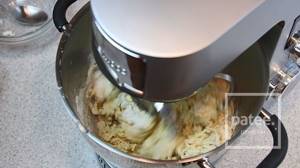
Mix the flour and baking powder as thoroughly as possible so that the baking powder is evenly distributed throughout the entire volume. Then we sift.
The margarine must be taken out of the refrigerator in advance and allowed to warm up. The margarine should not be rock hard; it should easily leave a fingerprint on it. But at the same time, the margarine should not be so soft that you can easily press it through with your finger.
Calorie content of potato cakes
Potato cakes decorated with cream look very appetizing and literally melt in your mouth. To prepare them, use shortbread or biscuit cookies. The calorie content of cakes made with sponge cake will be lower
. Shortbread cookies are more nutritious. For example, the calorie content of Yubileinoye cookies is 467 kcal, and the average calorie content of a biscuit is about 275 kcal.
At home, potato cakes are usually prepared from shortbread cookies. The same cakes that are purchased in stores and cafes are usually prepared on a sponge cake basis. Therefore, homemade potato cake has a higher calorie content than that purchased in the confectionery department of the store.
Confectionery shops usually use a standard recipe. Therefore, the energy value of cakes produced at different enterprises does not differ significantly. On average, a “store-bought” potato cake has a calorie content of 380-400 kcal.
Calorie content of meringue and sponge cakes
Meringue cakes are airy and light. They are prepared from egg whites and a significant amount of sugar. For all their airiness, “meringues” contain almost 70 g of carbohydrates per 100 g of product and no more than 4 g of protein. And the calorie content of weightless cakes is approximately the same as that of a “basket” - on average, 375 kcal.
Sponge cakes, especially fresh ones, soaked in cognac syrup and exquisitely decorated, will leave few people indifferent. The calorie content of sponge cakes with fruit filling is about 350 kcal, that is, approximately equal to the calorie content of custard cakes with protein cream. If you use butter cream as a layer and decoration for sponge cakes, then their energy value can increase to 400 kcal.
The calorie content of cakes is undoubtedly very high.
. However, knowing their energy value, you can easily plan your daily menu in such a way that there is a place in it for your favorite delicacy. For example, you decided that the energy value of foods eaten during the day should not exceed 1500 kcal. This means that for breakfast you can eat 100 g of cottage cheese with 5 percent fat content (121 kcal) and drink a cup of unsweetened green tea. And for second breakfast, a luxurious treat awaits you - your favorite cake with a cup of unsweetened tea or coffee. The calorie content of a cake, let it be, for example, an eclair with custard, is 280 kcal.
For lunch, you can eat a serving of vegetarian borscht (90 kcal) with bread (140 kcal) and 100 steamed pink salmon (143 kcal).
For an afternoon snack, eat 5 dried apricots (110 kcal) and 5 walnut kernels (250 kcal).
For dinner, you can eat 1-2 hard-boiled eggs (70-140 kcal), and a large portion of cucumber and tomato salad, seasoned with 1 teaspoon of vegetable oil and lemon juice (250 g - 235 kcal).
As you can see, the high calorie content of the cake did not become an obstacle to finding a place for this delicacy in a rather strictly verified menu. Of course, you should understand that while indulging yourself from time to time with such high-calorie sweets, you should not forget about physical activity. By the way, recent studies show that sweets eaten in the first half of the day will not seriously harm your figure. But carbohydrates consumed at night almost inevitably turn into fat deposits on the body.
Custard cake contains on average from 250 to 400 kcal.
Custard cake contains on average from 250 to 400 kcal.
This is one of the most high-calorie desserts. On our website you can find information about how many calories are in meringue or chocolate.
This difference in calories is explained by the fact that custard pies can have different fillings: curd, butter, cream or protein. Custard cakes covered with chocolate glaze are also popular. By the way, these are the cakes that are considered the most high-calorie.
Interestingly, the benefits of custard cakes are inversely proportional to their calorie content. In other words, the fewer calories in a treat, the more benefits it will provide.
For example, quiche is considered to be the lowest in calories. It contains the following useful elements:
- macroelements: calcium, magnesium, phosphorus and potassium;
- trace elements: zinc, fluorine, selenium, manganese and copper;
- choline, as well as B vitamins, vitamins A, D, C and E.
By the way, custard cakes can be prepared at home. Of course, it cannot be said that even novice housewives can do this dish, however, if you have certain skills, you will be able to prepare it. And, of course, cakes prepared at home will be more beneficial, since the presence of preservatives, flavor enhancers and emulsifiers is minimized.
The calculator below will help you determine how many calories are in custard cake
.
To do this, fill in the blanks and click “Calculate”. How many calories
How many calories are in meringue cake?

Meringue is truly the best treat for our figure. His caloric intake is minimal. How many calories are in dry meringue? If the delicacy is prepared according to the classic recipe, then a one hundred gram portion will contain about two hundred and fifty kilocalories.
Would you say this is a lot? However, such a dessert is so light that it is impossible to eat such a portion at once. Accordingly, the question arises - how many calories are in 1 meringue? One cake only provides us with fifty-four kilocalories. The whole secret of meringue lies in its composition, which is based on low-fat components - egg whites and granulated sugar.
On a note! It is better to eat meringue before lunch. Then your body will “process” carbohydrates until the evening, and they will not “stay”, bringing extra pounds to your figure.
Classic meringues (another name for meringue) are prepared in this way. First you need to beat, as they say, the protein component of the eggs until stiff peaks form. To make this happen, follow these recommendations. First, pre-cool the eggs. It is difficult to bring warm whites to the consistency of strong foam.
Secondly, carefully separate the white part from the yolks. Not a milligram of yolks should get into it. Thirdly, you must first beat the squirrels at the minimum speed of the kitchen gadget. Also, add a little salt to the whites.
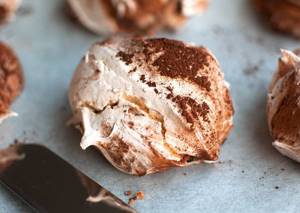
On a note! Experienced confectioners beat the protein mass without the use of kitchen gadgets - by hand.
Fourthly, you can add granulated sugar only when the whites reach the desired structure. Add it in small portions, continuing to beat the meringue mixture. In general, you need to beat the mixture for at least thirty minutes, otherwise the meringues will not be airy and tender in taste. During this time, the workpiece will become the desired thickness and be fully saturated with air.
When all the sugar crystals have dissolved in the dough, you can bake the meringues. It is better to cook them in the oven, then the meringue will not “gain” extra calories. Place the cake blanks on a baking sheet covered with a sheet of parchment using a pastry syringe. You can just use a tablespoon, but then the base will be of a regular round shape.
Aren't you afraid of extra centimeters on your waist? Top the meringues with cream. How many calories are in meringue with cream? The calorie content of such a treat is three hundred and eighty kilocalories per one hundred gram serving.
Calorie calculator
The old version of the calorie calculator has been saved, you can find it.
To prepare the cakes, wheat flour, sugar, butter, milk powder, eggs, salt, vanillin, cognac, alcohol, margarine, and sorbic acid are used. The delicacy is rich in vitamins B, H, E, minerals zinc, selenium, potassium, chlorine, calcium, cobalt, phosphorus, boron, molybdenum.
Due to their high calorie and fat content, eclairs with custard are contraindicated when losing weight. With frequent consumption of sweets, the intestinal microflora is disrupted, extra pounds are quickly gained, and the risk of constipation increases.
If you want to get in good physical shape, nutritionists do not recommend eating eclairs. For those with a sweet tooth who cannot refuse cakes, it is recommended to eat no more than 1 piece per day and in the first half of the day. This will significantly minimize the risk of weight gain.
Benefit or harm?

Don't believe sweet treats can be healthy? Believe me, meringue is one of those treats! Due to the increased content of nicotinic acid, vitamins H and B, and choline in meringues, this dessert really has a beneficial effect on our body. These components lower cholesterol levels and help cope with depression. They will also support the activity of the cardiovascular system, improve memory, and strengthen nerves.
But meringue can also cause harm. And all because of the amount of granulated sugar in it. Eating meringues in excessive quantities can cause tooth decay and, of course, weight gain. Therefore, control the portions of treats.
Meringue should not be eaten by those who are allergic to egg whites. Also, those who have been diagnosed with high cholesterol levels should avoid such treats.
Calorie content of eclair with cream per 100 grams
Calorie content of eclair with cream per 100 grams is 216 kcal. 100 g of product contains:
- 4.6 g protein;
- 12.8 g fat;
- 21.2 g carbohydrates.
Recipe for eclairs with cream:
- 120 ml of milk is mixed with 120 ml of water;
- Add 100 g of butter to the resulting mixture. All this is boiled to a boil;
- pour 150 g of flour sifted with 1 teaspoon of salt into the boiling liquid. Removed from the heat, the mixture is thoroughly mixed, infused for a quarter of an hour, heated again over the fire and kneaded until a ball-shaped dough is obtained;
- Beat 4 chicken eggs with a mixer and knead together with the dough;
- Place the dough in a pastry bag, squeeze out the eclairs onto a baking tray lined with baking paper;
- eclairs are baked in the oven at 220° C for 20 - 25 minutes;
- to prepare the cream, beat 280 ml of cream with 100 g of powdered sugar;
- Eclairs are filled with prepared cream using a pastry syringe.
Recipe for cake with cream. Calorie, chemical composition and nutritional value.
Nutritional value and chemical composition of “Cream cake”.
The table shows the nutritional content (calories, proteins, fats, carbohydrates, vitamins and minerals) per 100 grams of edible portion.
| Nutrient | Quantity | Norm** | % of the norm in 100 g | % of the norm in 100 kcal | 100% normal |
| Calorie content | 95.1 kcal | 1684 kcal | 5.6% | 5.9% | 1771 g |
| Squirrels | 8.4 g | 76 g | 11.1% | 11.7% | 905 g |
| Fats | 0.6 g | 56 g | 1.1% | 1.2% | 9333 g |
| Carbohydrates | 13.8 g | 219 g | 6.3% | 6.6% | 1587 g |
| Organic acids | 0.4 g | ~ | |||
| Alimentary fiber | 1 g | 20 g | 5% | 5.3% | 2000 g |
| Water | 75.5 g | 2273 g | 3.3% | 3.5% | 3011 g |
| Ash | 0.269 g | ~ | |||
| Vitamins | |||||
| Vitamin A, RE | 2.7 mcg | 900 mcg | 0.3% | 0.3% | 33333 g |
| beta carotene | 0.016 mg | 5 mg | 0.3% | 0.3% | 31250 g |
| Vitamin B1, thiamine | 0.016 mg | 1.5 mg | 1.1% | 1.2% | 9375 g |
| Vitamin B2, riboflavin | 0.011 mg | 1.8 mg | 0.6% | 0.6% | 16364 g |
| Vitamin B4, choline | 1.83 mg | 500 mg | 0.4% | 0.4% | 27322 g |
| Vitamin B5, pantothenic | 0.038 mg | 5 mg | 0.8% | 0.8% | 13158 g |
| Vitamin B6, pyridoxine | 0.043 mg | 2 mg | 2.2% | 2.3% | 4651 g |
| Vitamin B9, folates | 1.076 mcg | 400 mcg | 0.3% | 0.3% | 37175 g |
| Vitamin C, ascorbic acid | 5.38 mg | 90 mg | 6% | 6.3% | 1673 g |
| Vitamin E, alpha tocopherol, TE | 0.108 mg | 15 mg | 0.7% | 0.7% | 13889 g |
| Vitamin H, biotin | 0.161 mcg | 50 mcg | 0.3% | 0.3% | 31056 g |
| Vitamin K, phylloquinone | 1.2 mcg | 120 mcg | 1% | 1.1% | 10000 g |
| Vitamin RR, NE | 0.2151 mg | 20 mg | 1.1% | 1.2% | 9298 g |
| Niacin | 0.161 mg | ~ | |||
| Macronutrients | |||||
| Potassium, K | 149.52 mg | 2500 mg | 6% | 6.3% | 1672 g |
| Calcium, Ca | 8.61 mg | 1000 mg | 0.9% | 0.9% | 11614 g |
| Silicon, Si | 1.076 mg | 30 mg | 3.6% | 3.8% | 2788 g |
| Magnesium, Mg | 4.84 mg | 400 mg | 1.2% | 1.3% | 8264 g |
| Sodium, Na | 13.98 mg | 1300 mg | 1.1% | 1.2% | 9299 g |
| Sera, S | 2.69 mg | 1000 mg | 0.3% | 0.3% | 37175 g |
| Phosphorus, P | 5.9 mg | 800 mg | 0.7% | 0.7% | 13559 g |
| Chlorine, Cl | 1.08 mg | 2300 mg | 212963 g | ||
| Microelements | |||||
| Aluminium, Al | 59.2 mcg | ~ | |||
| Bor, B | 131.8 mcg | ~ | |||
| Vanadium, V | 2.15 mcg | ~ | |||
| Iron, Fe | 1.183 mg | 18 mg | 6.6% | 6.9% | 1522 g |
| Yod, I | 1.08 mcg | 150 mcg | 0.7% | 0.7% | 13889 g |
| Cobalt, Co | 0.538 mcg | 10 mcg | 5.4% | 5.7% | 1859 |
| Lithium, Li | 0.43 mcg | ~ | |||
| Manganese, Mn | 0.0253 mg | 2 mg | 1.3% | 1.4% | 7905 g |
| Copper, Cu | 59.16 mcg | 1000 mcg | 5.9% | 6.2% | 1690 g |
| Molybdenum, Mo | 3.227 mcg | 70 mcg | 4.6% | 4.8% | 2169 g |
| Nickel, Ni | 9.143 mcg | ~ | |||
| Rubidium, Rb | 33.9 mcg | ~ | |||
| Selenium, Se | 0.161 mcg | 55 mcg | 0.3% | 0.3% | 34161 g |
| Strontium, Sr | 1.83 mcg | ~ | |||
| Fluorine, F | 4.3 mcg | 4000 mcg | 0.1% | 0.1% | 93023 g |
| Chromium, Cr | 2.15 mcg | 50 mcg | 4.3% | 4.5% | 2326 g |
| Zinc, Zn | 0.0807 mg | 12 mg | 0.7% | 0.7% | 14870 g |
| Zirconium, Zr | 1.61 mcg | ~ | |||
| Digestible carbohydrates | |||||
| Starch and dextrins | 0.43 g | ~ | |||
| Mono- and disaccharides (sugars) | 4.8 g | max 100 g | |||
| Glucose (dextrose) | 1.076 g | ~ | |||
| Sucrose | 0.807 g | ~ | |||
| Fructose | 2.958 g | ~ | |||
| Essential amino acids | 0.047 g | ~ | |||
| Arginine* | 0.005 g | ~ | |||
| Valin | 0.006 g | ~ | |||
| Histidine* | 0.004 g | ~ | |||
| Isoleucine | 0.007 g | ~ | |||
| Leucine | 0.01 g | ~ | |||
| Lysine | 0.01 g | ~ | |||
| Methionine | 0.002 g | ~ | |||
| Methionine + Cysteine | 0.005 g | ~ | |||
| Threonine | 0.006 g | ~ | |||
| Tryptophan | 0.002 g | ~ | |||
| Phenylalanine | 0.005 g | ~ | |||
| Phenylalanine+Tyrosine | 0.011 g | ~ | |||
| Nonessential amino acids | 0.112 g | ~ | |||
| Alanin | 0.009 g | ~ | |||
| Aspartic acid | 0.042 g | ~ | |||
| Glycine | 0.008 g | ~ | |||
| Glutamic acid | 0.023 g | ~ | |||
| Proline | 0.007 g | ~ | |||
| Serin | 0.009 g | ~ | |||
| Tyrosine | 0.003 g | ~ | |||
| Cysteine | 0.003 g | ~ | |||
| Saturated fatty acids | |||||
| Saturated fatty acids | 0.1 g | max 18.7 g |
The energy value of Cream Pie is 95.1 kcal.
Primary Source: Created in the application by the user. Read more.
** This table shows the average levels of vitamins and minerals for an adult. If you want to know the norms taking into account your gender, age and other factors, then use the “My Healthy Diet” application.
Benefits of eclair
Classic eclairs with custard and condensed milk do not provide any benefit to the body. If you cannot give up sweets, we recommend that you use dietary recipes in which harmful components are replaced with healthy ones. So, to prepare the dough, you can use oatmeal as one of the ingredients, which normalizes the functioning of the gastrointestinal tract and reduces cholesterol levels.
Nutritionists advise adding whipped cottage cheese to the cake filling. It contains a lot of calcium that is beneficial for nails, hair and bones.
Meringues for decorating confectionery masterpieces
We already know how to prepare classic meringues that can be served as an independent treat. Now let's learn how to bake meringues to decorate various confectionery products.

Ingredients:
- eggs - three pieces;
- granulated sugar – 150 g;
- freshly squeezed lemon juice - one teaspoon. spoon;
- food coloring of any shade;
- confectionery food pearls - one to two teaspoons.
Preparation:
- We will prepare the components and devices we need.
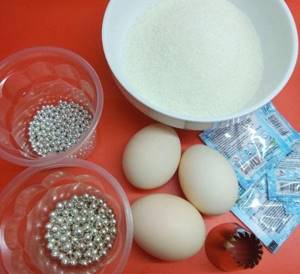
- It is better to use large pearls.
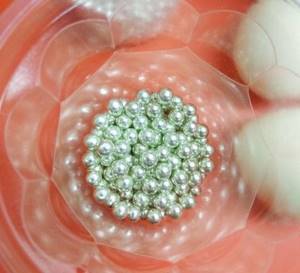
- But if this is not the case, take smaller pearls.
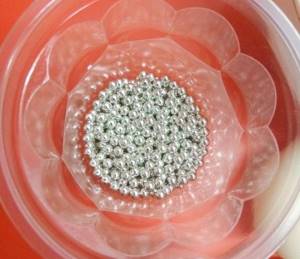
- We also need a nozzle like this.

- So, in any convenient way (using a bottle, a special device), we separate the white part of the eggs from the yolks.
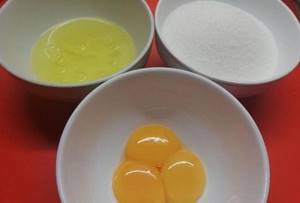
- We begin to beat the protein mass at low speed. It should acquire a structure of persistent peaks.
- Then add granulated sugar in small portions, without ceasing to work with the kitchen gadget.
- When all the sugar crystals have dissolved, add lemon juice.
- Let's beat the mixture for a couple more minutes.
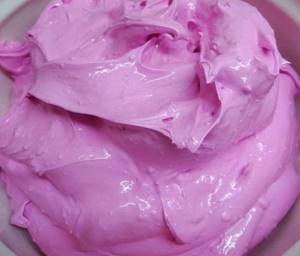
- Now let's introduce the dye of the selected color. Ours is pink. By the way, you can carefully divide the mass and paint it in different colors.

- Stir the mixture with a spoon. You can beat it again with a mixer.
- Line a baking sheet with a sheet of parchment.

- Using the nozzle, we form meringues and immediately place them on a baking sheet.
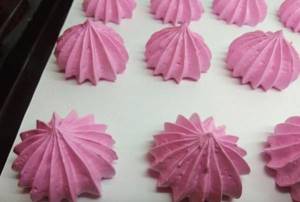
- Place a pearl in the middle of each meringue.
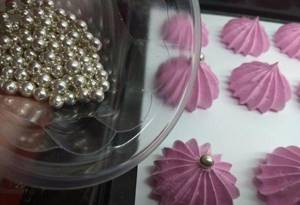
- Bake the meringue at ninety to one hundred degrees for sixty minutes.
- Now you can decorate, for example, a cake with meringues.
The harm of eclairs
Regular consumption of eclairs causes the following harm to health:
- extra pounds are gained;
- metabolism slows down;
- the risk of constipation increases;
- intestinal microflora is disrupted;
- diseases of the endocrine system develop;
- the likelihood of developing caries increases.
The product is contraindicated for diseases of the liver, gall bladder, pancreas, and stomach. Eclairs should be avoided if you are obese or have diabetes.
My husband is virtually cheating, what should I do?
28.01.2021
How to maintain a relationship with a loved one if it is on the verge of breaking up
28.01.2021
The husband found correspondence with another
28.01.2021
